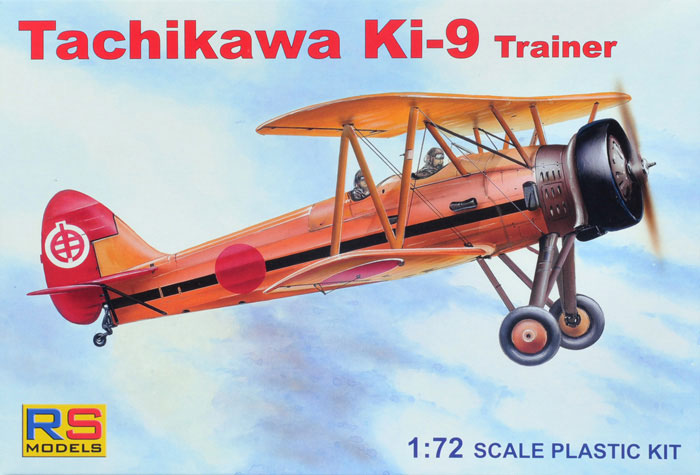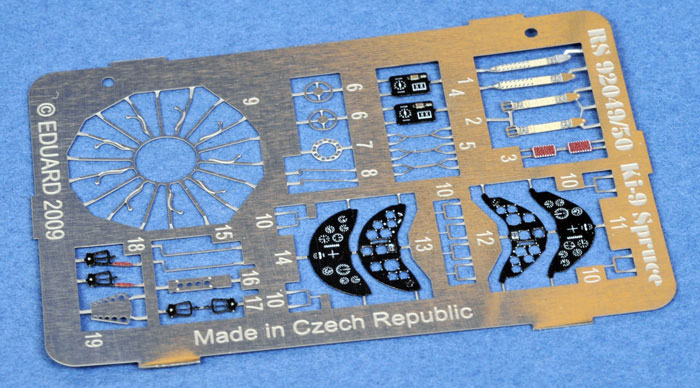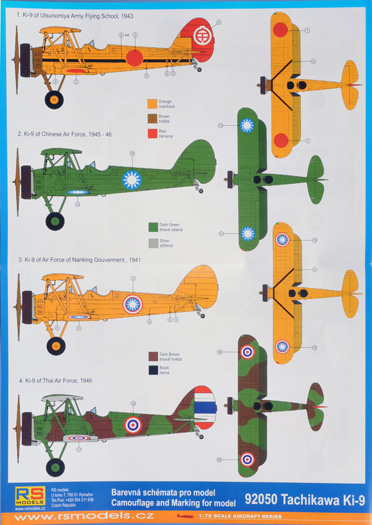Tachikawa Ki-9
Trainer

RS Models, 1/72 scale
S u m m a r y : |
Catalogue Number: |
RS Models 92050 Tachikawa Ki-9 Trainer Models |
Scale: |
1/72 |
Contents & Media |
43 tan coloured plastic parts on one sprue, 2 clear injection moulded plastic windscreens and 33 Eduard Pre-Painted PE parts on one fret plus decals for 4 aircraft. Paint/decal instructions are in the form of a double sided, full colour, A4 sized page plus the normal 4 page instructions with history, parts plan and 6 build diagrams. |
Price: |
Available online from Hannants from £12.43 |
Review Type: |
First Look |
Advantages: |
Highly detailed with flash free plastic mouldings, injected clear parts and Eduard PE. |
Disadvantages: |
Some experince will be required |
Conclusions: |
RS Models seem to have a penchant for Prototypes and Trainers, among others, but they do them very well and this Ki-9 is no exception. |
Reviewed by Glen Porter

HyperScale is proudly supported by Squadron.com
The Tachikawa Ki-9 was a single engined bi-plane trainer with unequal wing span built in the mid 30s. Originally intended for use as both basic and intermediate trainers, the basic trainer with a smalled engine was found to be unstable and discontinued.
First flown on the 7th of January 1935, over 2000 were built and used by the Japanese Air Force before and during the Second World War and post-war by the Chinese, South Koreans and Indonesia.
The Ki-9 was redesigned by Tachikawa to become the Ki-17 for basic training with the smaller engine.
RS Models from the Czech Republic, a relative new comer to the modelling world along with AZ Models from the same country and like the already established names, Eduard and MPM, is gaining quite a good reputation for high quality model kits. This Tachikawa Ki-9 kit will only add to that reputation.
The main plastic sprue is very cleanly moulded with no flash or sink marks and ejector pin marks only where they won't be seen. The parts have excellent detail including engraved panel lines, raised where required. There is a five piece cockpit tub with delicate framing as separate parts which is almost to scale. The two fuselage halves have some detail moulded onto the inside and the one-piece wings are commendably thin, especially at the trailing edge. This sprue also includes a detailed engine, cowl, seats, prop, wheels and wing struts.
Two injection moulded windscreens are on their own sprue, very clear and thin.
An Eduard pre-coloured PE fret has two instrument panels, lap seat harnesses, push rods for the engine and various other bits for the cockpit and exterior of the model.

Decals by Rising Decals demonstrate perfect register, good colours and minimum carrier film. There are markings for 4 options beginning with a Ki-9 in over-all orange from the Utsunomiya Army Flying School, 1943. It has a black cowl, red rudder and brown just behind the engine and including the A/C struts.

A Chinese Air Force Ki-9, circa 1945-6 is in over-all dark green but no F.S. Number or any other type of colour code is given.
Next is a Ki-9 of the Air Force of the Nanking government in 1941. It is in the same over-all colour as the first example but without the Brown or red areas.
Lastly, a Thai Air Force aircraft, 1946 in dark green/dark brown above and silver under sides but again no specific colour is given. It has red/white/blue/white/red roundels in the usual six positions and the rudder is horizontally striped in the same colours.

My only criticism of this kit is the instructions. At first glance, they look to be reasonable but then you will notice that each diagram is surrounded by part numbers. The problem is, the part numbers are not connected to the relevant parts. I had to keep going back to the parts plan with the number and then see if I could find the part in the instructions. Some parts I couldn't find at all and others I think are miss-numbered. Anyhow, this is a problem I haven't seen in other RS kits so it may-be just a printing glitch in this particular kit.
No kit is perfect, and this is no exception. However, if there must be problem, I think I would rather them in the instructions where they would be much easier to fix by the Manufacturer than in the model itself. 7 out of 10 for the instructions but the rest is BLOODY good.
Thanks to RS Models for the sample
Review Text Copyright © 2009 by Glen Porter
Page Created 16 April, 2009
Last updated
16 April, 2009
Back to HyperScale Main Page
Back to Reviews Page |
